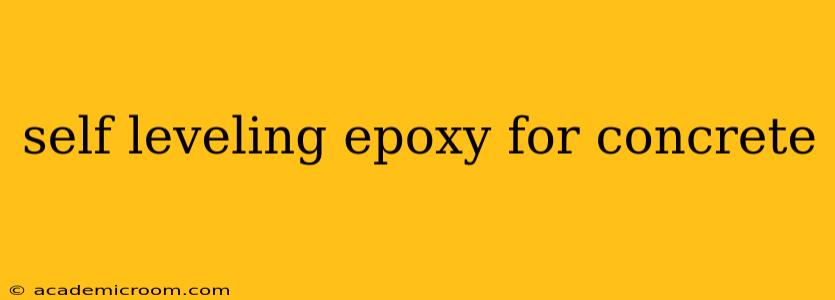Self-leveling epoxy is a game-changer for concrete floors, offering a durable, seamless, and aesthetically pleasing finish. Whether you're tackling a DIY project in your garage or overseeing a large-scale commercial application, understanding the nuances of self-leveling epoxy is crucial for success. This comprehensive guide will explore everything you need to know about this versatile flooring solution.
What is Self-Leveling Epoxy?
Self-leveling epoxy is a type of two-part epoxy resin system designed to flow smoothly and self-level across a concrete surface, creating an incredibly even and flat finish. Unlike traditional epoxy coatings that require extensive troweling, self-leveling epoxy utilizes its inherent properties to eliminate imperfections and create a polished, professional look. The mixture typically consists of a resin and a hardener, which are combined to initiate the curing process. Once cured, it forms a robust, chemical-resistant coating that's ideal for various applications.
Why Choose Self-Leveling Epoxy for Concrete?
Self-leveling epoxy offers a multitude of advantages over other concrete flooring options:
- Exceptional Durability: Resistant to abrasion, chemicals, and impacts, making it suitable for high-traffic areas.
- Seamless Finish: Eliminates cracks, gaps, and other imperfections for a smooth, aesthetically pleasing surface.
- Easy Maintenance: The non-porous nature of epoxy makes it easy to clean and maintain.
- Chemical Resistance: Provides a protective barrier against various chemicals and spills.
- Customization: Available in a wide range of colors and finishes to match any design aesthetic.
How is Self-Leveling Epoxy Applied?
The application process involves several key steps:
- Surface Preparation: This is arguably the most critical step. The concrete surface must be thoroughly cleaned, primed, and prepared to ensure proper adhesion. Any cracks or imperfections should be repaired before application.
- Mixing: The resin and hardener must be mixed precisely according to the manufacturer's instructions to achieve the correct viscosity and curing properties.
- Pouring: The mixed epoxy is poured onto the prepared surface, allowing it to self-level naturally.
- Degassing: Using a spiked roller or other degassing tool helps remove trapped air bubbles for a flawless finish.
- Curing: The epoxy needs sufficient time to cure, typically 24-72 hours depending on the product and environmental conditions.
What are the Different Types of Self-Leveling Epoxy?
The market offers various self-leveling epoxy formulations catering to specific needs and applications:
- High-build epoxy: Ideal for filling larger cracks and imperfections, requiring a thicker application.
- Thin-film epoxy: Suitable for surfaces with minimal imperfections, requiring a thinner application for a smooth, glossy finish.
- UV-resistant epoxy: Designed to withstand prolonged exposure to sunlight without yellowing or degrading.
- Colored epoxy: Available in a vast array of colors to enhance the aesthetic appeal of the floor.
How Much Does Self-Leveling Epoxy Cost?
The cost of self-leveling epoxy varies considerably depending on factors like:
- Coverage area: Larger areas naturally increase the cost.
- Product type: High-build epoxy generally costs more than thin-film epoxy.
- Labor costs: Hiring professionals significantly increases the overall expense.
Can I Apply Self-Leveling Epoxy Myself?
While DIY application is possible for smaller projects, it requires careful planning and preparation. Larger projects are best left to experienced professionals to ensure a flawless and long-lasting result. Improper application can lead to issues like uneven surfaces, incomplete curing, and premature failure.
How Long Does Self-Leveling Epoxy Last?
With proper application and maintenance, self-leveling epoxy can last for many years, even decades. Its durability and resistance to wear and tear contribute to its longevity.
What are the Potential Problems with Self-Leveling Epoxy?
While highly durable, self-leveling epoxy can be susceptible to certain issues:
- Improper Mixing: Incorrect mixing ratios can lead to incomplete curing or a weakened finish.
- Poor Surface Preparation: Inadequate surface preparation can result in poor adhesion and premature failure.
- Temperature Fluctuations: Extreme temperatures during application or curing can affect the final outcome.
How to Maintain a Self-Leveling Epoxy Floor?
Maintaining a self-leveling epoxy floor is relatively straightforward. Regular sweeping or vacuuming is sufficient, along with occasional mopping with a mild detergent solution. Avoid abrasive cleaners or harsh chemicals.
This guide provides a comprehensive overview of self-leveling epoxy for concrete. Remember to always consult the manufacturer's instructions for specific product details and application guidelines. By following these steps and understanding the intricacies of this versatile material, you can achieve a stunning and durable concrete floor that will last for years to come.
